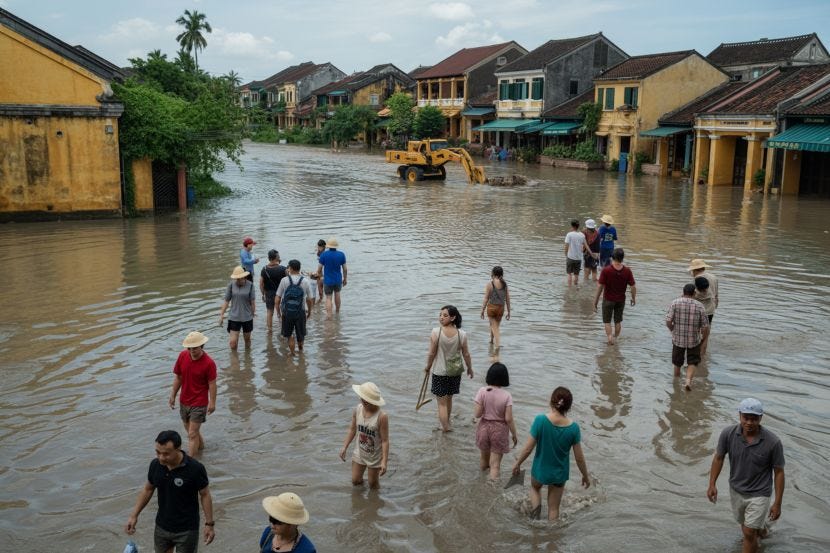🇻🇳 Vietnam flood crisis: Death toll reaches 90 as central provinces face widespread devastation
The Land of the Rising Dragon battles one of its deadliest flood seasons in years

🎯 The Main Takeaway
At least 90 people have died and 12 remain missing after days of intense flooding and landslides since Nov. 16 across central Vietnam, one of the deadliest climate disasters to hit the region this year.
Dak Lak suffered the worst losses with 63 fatalities, followed by Khanh Hoa (14) and several other provinces reporting casualties and severe damage.
Floodwaters are slowly receding, but entire communes remain submerged, and 257,000 homes are still without electricity.
Damage is estimated at VND9 trillion (USD341.5 million).
🔍 Why It’s on Our Radar
Extreme rainfall topped 1,900 mm in parts of central Vietnam — overwhelming rivers, roads, hospitals, and power lines.
Severe landslides cut off major highways, stranding travellers for kilometres.
Hospitals in Binh Dinh were flooded so badly that patients had to survive on instant noodles for three days.
The region is a key coffee belt and tourism hub, raising concerns about wider economic fallout.
With climate change intensifying storms, the frequency of “historic floods” in Vietnam is rising sharply.

⚠️ What’s at Stake?
🏘️ Communities
Tens of thousands of homes were flooded, 1,154 of them damaged beyond use.
Several communes in Dak Lak remain deeply underwater, especially Hoa Thinh and Hoa Xuan.
⚡ Infrastructure
1.2 million households lost power at the peak of the disaster; outages still affect hundreds of thousands, cutting mobile and internet access.
17 national highway sections remain blocked or heavily flooded.
🚜 Economy
Vietnam’s central region is a major exporter of coffee, seafood and tourism — all facing disruption.
Repair and relief costs will significantly strain local budgets.
❤️ Why This Hits Home
Ho Chi Minh City residents have launched one of the largest volunteer drives of the year, filling metro stations, apartment lobbies and public offices with donated goods.
Ben Thanh, Suoi Tien and Thu Duc stations have become round-the-clock relief hubs.
The Vietnam Fatherland Front Committee ran out of storage space after just one day.
Volunteers — from students to families — are sorting clothes, food and essentials to be shipped directly to Khanh Hoa, Dak Lak and Gia Lai.
This is community solidarity at scale.

📸 The Big Picture
Floods and landslides have paralysed central Vietnam’s transport network:
National Highways 1, 20, 26 and 27C suffered severe damage.
Landslides tore apart Mimosa Pass and Khanh Le Pass, forcing long detours.
Expressway traffic near Nha Trang and Phan Rang had to be redirected as police worked to prevent dangerous bottlenecks.
Emergency crews remain on 24-hour duty as new incidents emerge with each wave of rainfall.
🌏 Beyond the Headlines
This disaster underscores a deeper regional truth:
Southeast Asia is increasingly vulnerable to climate-driven storms, landslides and floods, with Vietnam at the frontline.
From the Philippines’ typhoons to Indonesia’s coastal erosion, weather extremes are outpacing infrastructure — and hitting the most vulnerable communities hardest.
Vietnam’s response this week shows two realities:
The climate threat is accelerating.
The spirit of mutual aid remains strong.
👉 The Bottom Line
Central Vietnam is beginning to dry, but recovery will take months.
As volunteers mobilise nationwide, the scale of damage reveals an urgent need for stronger infrastructure, climate-ready planning, and cross-regional support — because disasters of this magnitude are no longer rare.
Need More Angles?
The Guardian Vietnam flooding death toll reaches 90 amid landslides and relentless rain
VNExpress Central Vietnam’s traffic routes crippled as floods and landslides shut mountain passes
VNExpress HCMC residents send urgent relief supplies to flood-hit central Vietnam
(ELS/QOB)




